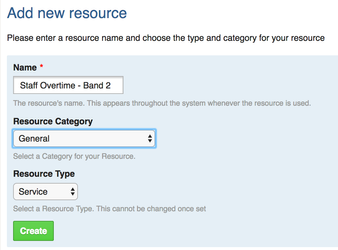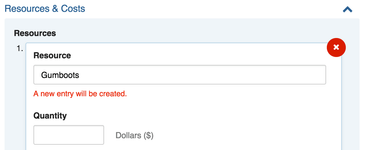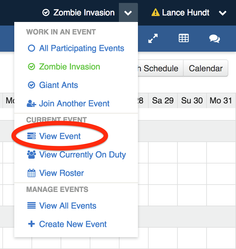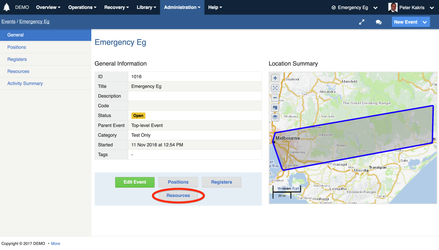Managing Resources
On this page
Overview
Resources have a few different functions in Crisisworks. The primary use for resources is to track costs and usage of items or services. Examples of resources may be subcontractors, vehicles, or services. or costs like "Staff Overtime - Band 1"
Each resource has a history of its usage so you can look at a resource and see everywhere where it has been used and the costs associated.
Resource can be pre-created in the Administration → Resources section by Crisisworks administrators, or ad-hoc resources can be added from requests. The resource data includes the costs and unit of measurement such as $50/hour, $5 per litre , $500 per day or $40 each.
Resources are linked to each event, so it is important that your events templates contains the resources you would like to have so the new events created have the resources needed. Note you can multiple event templates each could have different sets of resources in them, based on the event template. Resources can also be added to an event after it has been created.
Using resources
For the core modules resources are used in Requests, Infrastructure Assessments and in Cases in the Needs & Tasks section. Resources are used to manage contractors in fire prevention notes, Resources are also used in some other customised modules.
Details on how to add an existing resource to a record will be covered in the relevant sections for those register types.
Editing resources
Crisisworks administrators or Resource managers can create and edit resources.
- Select Resources from the settings menu
- Find the resource you want to edit, you can use the tag or category counters, or perform a text search. You can use the magnifying glass to filter the list. Note you can use wild cards like bob* to search for "bob cat", or "Bob jones Pty Ltd"
- Click on the resource ID or resource title to view the resource
- Press the green Edit Resource Button
- Make the changes needed, then press save. See the notes below in the section "How create system resources” for details of the core fields.
- Press save
Adding resources
Crisisworks administrators or resource managers can create and edit resources.
To add a new resource there are two options, pre-define them for later use, or create an ad-hoc resource from within a request.
How create system resources
Step 1: Select Administration > Resources from the menu
Step 2: Before creating a new resource make sure doesn’t already exist, by searching for it.
You can use the magnifying glass to filter the list. Note you can use wild cards like bob* to search for "bob cat", or "Bob jones Pty Ltd”
Step 3: Select New Resource from the button at the top right-hand side of the resource datagrid.
Step 4: Choose the resource category and type.
The Resource Category will affect which modules it will be available in. The general category will be available in most registers, and some resources type like “Fire Prevention Contractors” only appear if you have the extra module licensed.
The choice of Resource Type will affect which fields will be shown on the following screen. The choices for Resource Type are Consumable, Equipment and Service.
Step 5: After pressing the “New Resource” button on the RHS of the datagrid, fill in the data fields
Many of the fields are obvious however these following fields are the core fields needed to tack costs, this diagram shows how the data fields fields will be presented in the request entry screen.
Step 6: After you have created your resource(s) ensure that you add them to your event templates, so they will be copied into new events in the future.
Tip: If you create all of your resources in bulk, you can add multiple resources to your events at the same time.
How to create an ad-hoc resource
When you are in a request and you wish to use a resource but release the resource has not been created yet, you can create a basic resource from within the request,
Step 1: Press the “Add new” button, to add a new resource to the request
Step 2: Start typing to search the pre-defined resources, as you type you will see a list of any recourses that match the letters you have entered so far.
- Select the resource you wish to use from the list, then enter the quantity and other details.
- If no resources match, you will see the message “A new entry will be created”, and an ad-hoc resource will be added with the details you provide when you save the request
About ad-hoc resources
When adding a resource in-line, when you save the request it will create the new resource and will also add it to the current event.
The unit rate defaults to $1, so you are adding quantities of dollars, so you can just enter the total $ value of the item you which to the the cost of.
Tip: If you intend to convert this ad-hoc resource into a proper resource for re-use in the future, we recommend you use the Quantity as the number of items you want, then go and edit the resource and enter in the proper unit cost (see Editing resources section above)
Adding or removing resources in an event
When using resources, only resources that have already been added to the event can be search for and linked to the records in the event. You can update the list of resources participating within an event by following these steps.
Step 1: Navigate to the event overview page by clicking View Event from the event selector in the top right-hand side. You can also navigate via Administration > Events and then select the event from the list, if you wish to manage resources for another event.
Step 2: From the event overview screen press the “Resources” button
Step 3: Select the resource(s) you want to add to the event.
You can bulk add resources by selecting the check box in the a category header row
Each time you select the check box in the category header row, it will toggle all of the items in the category i.e. all become selected, then all become deselected
Step 4: Press Save at the bottom of the list to update resource participation for the event
The event is now updated with the added resources.
Resource categories
Resource categories are used to link the resource to one or more Crisisworks registers, so when you are searching to add an item, it will only filter on the items that are in the matching category.
| Name | Usage |
|---|---|
| General | Used within Request, Case, Infrastructure Assessment |
| General Equipment | Used within Request, Cases, Infrastructure Assessment |
| Fire Prevention Contractors | Used within Fire Prevention Notices |
Infrastructure Assessment Tasks | Used for the Infrastructure Assessment Module |
Recovery Services Tasks | Used in Recovery Cases within the Needs & Tasks register |
Additional categories may be present based on your licensed modules. See your module guides for details.
Exporting and reporting on resources
How to export your resource data
Run the resources report from reports section:
- Select Reports from the Overview menu.
- After you select the Resource Report from the list of reports
- Press the green Generate Report Button
- Choose the search parameters you want for the report
- Choose the fields you want to display
- Choose the grouping field, if you would like to group data together
- Choose the field to sort the results
- Press Run Report
The resulting report can be exported as CSV or an an Excel file
Event current resource usage and costs
- Click View Event from the event selector to go to the the event overview screen
- Press the Resources link on the left hand side
Importing resources
Importing resources will be added soon, it will be available in the same area that all other imports are done
- From the settings menu, select “Internals”
- From the left hand side select “Import Data”
- Under "What do you want to import?”, select resources
- Select your file
- Press import
It is advisable to use the test option when using the feature for the first time, it will test your import data without adding the data






